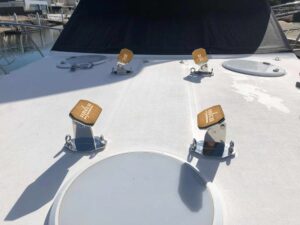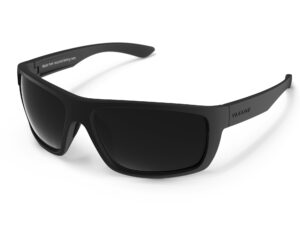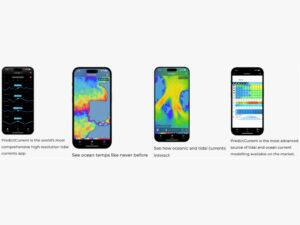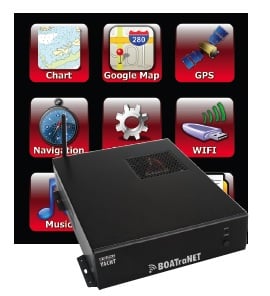
Botranet
Back when many of us started cruising, marine electronics were two things: expensive and hard to master. Thanks to the ongoing refinement of what computer developers call the graphical user interface and to huge strides in computer technology, these navigation devices have become accessible to all users. Touchscreens, digital charting, and the ability to access the Internet from just about anywhere on the planet are just a few of the technologies that have made it easier for us to navigate and to monitor the systems on our boats.
The problem we face today is the sheer number of products that are available. How does a boat owner choose what’s best? One good place to start is to take note of the Technology Awards presented annually by the National Marine Electronics Association, which has a panel of Boating Writers International marine-electronics writers examine the latest offerings and acknowledge what they consider to be the best products. Other helpful guides include the Design Award presented at Amsterdam’s Marine Equipment Trade Show and the IBEX Innovation Award, judged by the B.W.I. and given out at the 2011 International Boatbuilders Exhibition and Conference.
So let’s first take a look at the products that were selected as award winners by the experts. Then we’ll further winnow this year’s new entries in the crowded electronics marketplace and talk about which gear is likely to appeal to cruising sailors as they head out to see what’s new at the 2012 boat shows.
Winning the National Marine Electronics Association Technology Award for 2011 was Boatranet, a wireless server for onboard navigation networks that’s manufactured by Digital Yacht. Boatranet typifies the revolution that’s taking place all over the world today: the seamless integration of information with smartphones, iPads and other tablets, and laptop computers. Boatranet creates a wireless hotspot that allows anyone on board who’s password-enabled and equipped with a phone, tablet, laptop, or computer (running Apple, Windows, or Linux operating systems) to access the boat’s network. The technology also automatically creates animated instrument and navigational displays (web pages) of your data—and the data format is available to apps developers, so expect more bells and whistles to come.
Simply put, Boatranet creates an intranet for your boat so that anyone who’s logged in can see charts, instrument displays, Automatic Identification System targets, radar, engine gauges, or anything else on your boat’s network. When you’re in a marina or anchorage that has a network connected to the Internet, Boatranet, via an optional WiFi adapter, can connect to wireless hotspots and share that Internet connection to every device aboard. For those crewmembers who could care less about hard data, Boatranet can also stream music to your boat’s music system and share photos and documents.
Boatranet accepts data from Raymarine, Garmin, Furuno, Navico, and other electronics via NMEA 0183 or NMEA 2000, the communication protocols that allow different devices in a boat’s navigation system to talk to one another; the NMEA 2000 gateway is an optional extra. The Boatranet black box is compact, easy to install, and runs on 12 volts DC or 24 volts DC. To conserve power, it uses heatsinks rather than fans to stay cool, which means it only draws 1.5 amps.
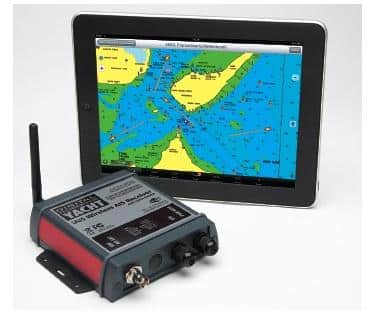
Another iDevice-friendly Digital Yacht product took home the Design Award presented at Amsterdam’s Marine Equipment Trade Show: iAIS (above), a wireless Automatic Identification System receiver that links with iPhone, iPad, and iPod Touch devices. It’s a black-box A.I.S. receiver that, when used with a free app available at Apple’s App Store, shows A.I.S. data as well as other NMEA data, including GPS, depth, speed, and wind information. The iAIS can also send data to a computer via a USB connection and to plotters via a hardwired NMEA connection. An iAIS can also accept and broadcast added NMEA 0183 data, in ways similar to its cousin, Boatranet.
Also weighing in with a take on the wireless world of marine electronics is Raymarine, a company that’s starting to see the benefits of being taken over by the thermal-imaging company FLIR Systems.
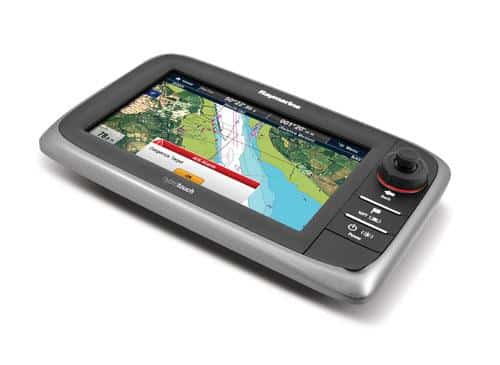
The e7 display (above) is a 2011 IBEX Innovation Award-winning multifunction display that uses the company’s successful HybridTouch technology, in which the user can employ either the touchscreen or the keypad to interface with the system. Add to that Raymarine’s intuitive drag-and-drop LightHouse interface, which makes it simple to change the display around to fit individual preferences, and it’s easy to see how the trickle-down effect from tablets and iDevices is making a big splash in our part of the marketplace. The e7 offers options for input from radar, A.I.S., marine weather, and, of course (thanks, FLIR Systems!), thermal night-vision scopes. The e7 can, of course, share data with iPhones and iPads as well.
Furuno is a heavyweight in marine electronics, especially at the commercial level, and its civilian products benefit greatly from the knowledge gleaned from heavy-duty users. Its NavNet 3D system took home two Technology Awards from the National Marine Electronics Association awards that are of interest to cruisers: Best Radar for the NavNet 3D DRS Ultra High-Definition Radar series, and Best Navigation System for the NavNet 3D MFD 12, which is a multifunction display.
The NavNet 3D MFD 12 has a bright, 12.1-inch screen and comes preloaded with NOAA raster and vector charts, or you can buy and install C-Map or Navionics Vector data, all in MapMedia format. All four of these types of digital charts can be shown in 3D or 2D mode, and additional satellite photos can be downloaded from Furuno’s website.
Furuno’s NavNet system uses TimeZero technology, which allows for instant chart redraw with no lag whatsoever, even in 3D mode, and even when using radar or weather overlays. This is groundbreaking stuff, as older multifunction displays often have significant lag time, especially when interpreting large amounts of data. Traditionalists will like the 2D, top-down view, but they’ll also find it easy to think in new ways and use the 3D view. The “Roto-key” input method is user-friendly, especially once you’re familiar with the menus, pages, and command functions accessed by this knob. The interface is also helped along by the point-and-click cursor-pad control, but you can also connect a traditional mouse via the USB port. Furuno, we hear, is planning a major product release in February, and “touchscreen” is all anyone will say about it.
Adding other components to the NavNet 3D MFD 12 is easy, whether done via Ethernet, NMEA 0183, or the newer NMEA 2000 networking. A.I.S., radar, depth, Sirius Satellite Weather, Navtex/weatherfax—the MFD 12 will accept and display all of these inputs and more. With the Sirius Weather add-on, the MFD 12 can overlay the chart with weather information, providing a real-time look at what’s happening around you.
One technology that’s proven a challenge to all but well-trained or experienced users is radar. Properly tuning and setting up radar has always been an art, and interpreting the data one sees can also be tough, even when the radar image is laid over a chart. Furuno hopes to take some of the mystery out of the experience with its DRS Ultra High-Definition Radar series.
Furuno’s latest radar technology offers a clear, noise-free signal thanks to automatic, real-time digital signal processing, and it has automatic gain, sea, and rain controls. If you’re a radar whiz, the system can step up to your level with its ability to display two different radar ranges while allowing autonomous manipulation of each range individually. If you understand all this technobabble, you’ll appreciate the system; what’s more important is that if you don’t, the system can still provide you with easy to understand data at your fingertips.
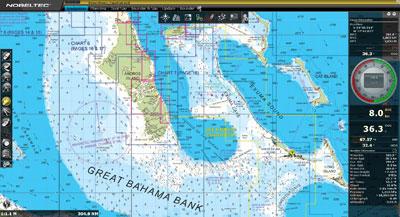
For those who use a PC for navigation rather than a multifunction display, another award-winner from Amsterdam’s Marine Equipment Trade Show stands out. Our old friend Nobeltec (partially owned by Furuno) has released TimeZero Trident (above). Boasting all of the features incorporated into Furuno’s NavNet software but designed for PC use, this software does it all, and does it seamlessly and with no lag, although users who load it onto older PCs may suffer from hardware slowdowns. TimeZero Trident also, of course, integrates well with NavNet systems. Best of all? No dongle is required to unlock the program, and a less expensive Odyssey version that can’t work in conjunction with radars has just been released.
Often neglected in any boat’s electronics suite is the VHF radio. Less expensive models offered today are still rich in features, so it’s hard to decide which model is best. By relying on award winners, we can once again separate the wheat from the chaff. The Matrix GX2150 radio from Standard Horizon is a feature-laden unit that has an integrated dual-channel A.I.S. receiver that allows you to use a single VHF antenna. This means that boats with older chart plotters can receive A.I.S. information from the Matrix GX2150 without requiring their existing VHF antenna to be replaced or another added. To make this even simpler, the GX2150 allows you to select the baud-rate output to your plotter from 4800 to 38400, which is great for plotters that only have one NMEA port.
When connected to a GPS, the GX2150 can display all the necessary A.I.S. target information (the Marine Mobile Service Identification number, Call Sign, Ship Name, Bearing, Distance, Speed Over Ground, and Course Over Ground), and it alerts you to any Closest Point of Approach issues with programmable C.P.A. or Time to Closest Approach collision-avoidance alarms. In addition, the GX2150 allows you to contact the ship directly using digital selective calling, a boon in crowded waterways.
Other features that make the GX2150 well worth its $400 price include a loud hailer/foghorn, a ClearVoice noise-cancelling speaker, NOAA Weather Alert, Programmable Scan, Priority Scan, and Dual Watch. It can also serve as a good basic backup for your chart plotter since it can store 100 waypoints and can display Speed Over Ground, Course Over Ground, Bearing, and Distance to Waypoint.
In addition to these award winners, there are plenty of other new electronic devices available to render your navigation easier, your entertainment more enjoyable, and your ability to connect with work, friends, and relatives—should you want to—more robust. As a sailor and a consumer, I find that the fun part is to play around with all of them until you find the one that best suits your needs.
Next Year’s Winner?
In its quest to avoid awarding kudos to manufacturers for vaporware—products that don’t really exist quite yet—the rules of the National Marine Electronics Association dictate that in order for products to be considered, they have to have been shipped to customers 60 days before the association’s annual conference. Thus, one of the latest and perhaps greatest new products of 2011-2012,** Broadband 4G radar** by Navico, wasn’t considered for this year’s awards despite its obvious promise.
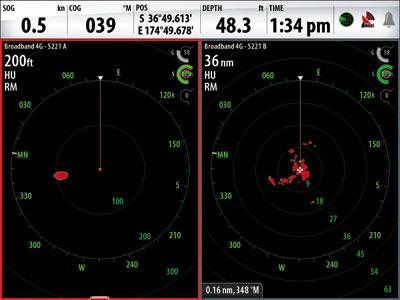
This solid-state, Frequency Modulated Continuous Wave radome claims 50 percent greater range and target detection than current 3G model radar.
Coupled with the increased range is what Navico calls Beam Sharpening, which improves the horizontal beam width. That means that even Navico’s compact, 18-inch radome can produce signals that one would normally expect from larger sets, and it makes 4G technology very appealing to owners of smaller boats that can’t carry large radar antennas. The Broadband 4G radar will be available from Simrad, Lowrance, and B&G, companies all owned by Navico.
The Broadband 4G radar also offers dual-range capability on some Navico multifunction displays, allowing a user to monitor an object such as a buoy or another boat as close as two meters away as well as such objects as land masses that are as much as 36 miles away, and even have the “separate” radars each overlaid on a chart window. All that, coupled with high resolution and an attractive price (as low as $1,900 for the Lowrance version), makes for an interesting option for those looking to add radar to their bag of navigation tricks.
Tony Bessinger, a frequent CW_ contributor, is a veteran captain and navigator._

